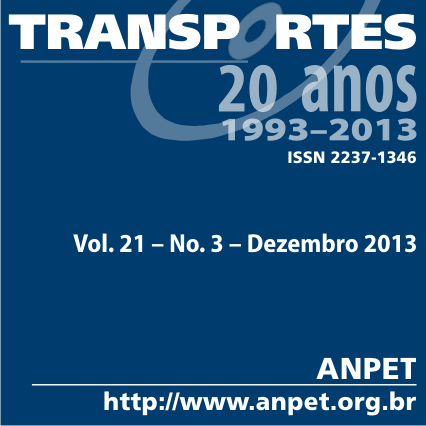PROCEDIMENTOS PARA ESTIMATIVA DE DISTÂNCIAS DE VIAGENS INTRAZONAIS POR BICICLETA
DOI:
https://doi.org/10.4237/transportes.v21i3.706Abstract
Este estudo teve como objetivo o desenvolvimento de procedimentos para estimar distâncias de viagens intrazonais por bicicleta com base em dados de pesquisas origem-destino (O/D). A análise partiu da identificação de características geométricas das zonas de análise de tráfego (TAZ) que podem influenciar as distâncias das viagens intrazonais. Em seguida, indicadores numéricos dos padrões geométricos selecionados foram comparados com os valores médios das distâncias intrazonais, a fim de procurar por evidências de correlações entre estas variáveis. Os casos com maiores correlações serviram de base para a construção de modelos destinados a estimar distâncias intrazonais. Os valores obtidos com estes modelos foram então comparados com as estimativas de um modelo encontrado na literatura. O melhor modelo aqui obtido superou claramente o modelo tradicional. Isto sugere que ele pode ser uma alternativa para substituir o modelo tradicional para estimar distâncias médias de viagens intrazonais, pelo menos no caso de viagens de bicicleta.
Downloads
References
Amancio, M.A. (2005) Relacionamento entre a forma urbana e as viagens a pé. Dissertação (Mestrado), Universidade Federal de São Carlos, São Carlos.
Batty, M. (1976) Urban Modeling: algorithms, calibrations, predictions. Cambridge Urban and Architectural Studies, vol. 3. Cambridge University Press, London.
Bhatta, B.P. e O.I. Larsen (2011) Are intrazonal trips ignorable? Transport policy, Vol. 18, n. 1, p. 13-22. 2011. DOI: 10.1016/j.tranpol.2010.04.004.
Caliper. (2008) TransCAD 5.0 - Transportation GIS Software Software. 1 CD-ROM.
Cervero, R. e M. Duncan (2003) Walking, bicycling and urban landscapes: Evidence from the San Francisco Bay area. American Journal of Public Health. Vol. 93, p. 1478-1483. DOI: 10.2105/AJPH.93.9.1478.
Cervero, R.; O.L. Sarmiento; E. Jacoby; L.F. Gomez e A. Neiman (2009) Influences of built environments on walking and cycling: lessons from Bogotá. International Journal of Sustainable Transportation. Vol. 3, n. 4, p. 265-284. DOI: 10.1080/15568310802178314.
Costa, P.T. (2003) Uma análise do consumo de energia em transportes nas cidades portuguesas utilizando Redes Neurais Artificiais. 133 f. Dissertação (Mestrado), Universidade do Minho, Braga, Portugal.
Costa, G. (2001) Uma avaliação do consumo de energia com transportes em cidades do estado de São Paulo, 2001. 102 f. Universidade de São Paulo, São Carlos.
Daganzo, C.F. (1984) The Length of tours in zones of different shapes. Transportation Research Board, Vol. 18B, n. 25, p. 135-145. DOI: 10.1016/0191-2615(84)90027-4.
Fotheringham, A.S. (1988) Market share analysis techniques: a review and illustration of current U.S. practice. In: N. Wrigley (eds.) Store Choice, Store Location and Market Analysis, pp. 120-159. Routledge, London.
IBGE (2010). Cidades. Instituto Brasileiro de Geografia e Estatística. Disponível em: <http://www.ibge.gov.br/cidadesat/topwindow.htm?1>. Acesso em: 30/04/2013
Khan, M. e L.M. Kockelman (2012) Models for anticipating non-motorized travel choices and the role of the built environment. In: Annual Meeting of the International Association for Travel Behavior Research, Toronto, Canada.
Kordi, M.; C. Kaiser e A.S. Fotheringhan (2012) A possible solution for the centroid-to-centroid and intra-zonal trip length problems. In: International Conference on Geographic Information Science, Avignon.
Rodrigues da Silva, A.N. (2008) Pesquisa Origem-Destino da Cidade de São Carlos. Relatório do projeto de pesquisa FAPESP (Fundação de Amparo à Pesquisa do Estado de São Paulo) número 04/15843-4. São Carlos.
Smeed, R.J. (1967) The road capacity of city centers. Highway Research Record, v. 169, p. 22-29.
Smeed, R.J (1968) Traffic studies and urban congestion. Journal of Transport Economics and Policy, v. 2, p. 33 - 70.
Downloads
Published
How to Cite
Issue
Section
License
Authors who submit papers for publication by TRANSPORTES agree to the following terms:
- The authors retain the copyright and grant Transportes the right of first publication of the manuscript, without any financial charge, and waive any other remuneration for its publication by ANPET.
- Upon publication by Transportes, the manuscript is automatically licensed under the Creative Commons License CC BY 4.0 license. This license permits the work to be shared with proper attribution to the authors and its original publication in this journal.
- Authors are authorized to enter into additional separate contracts for the non-exclusive distribution of the version of the manuscript published in this journal (e.g., publishing in an institutional repository or as a book chapter), with recognition of the initial publication in this journal, provided that such a contract does not imply an endorsement of the content of the manuscript or the new medium by ANPET.
- Authors are permitted and encouraged to publish and distribute their work online (e.g., in institutional repositories or on their personal websites) after the editorial process is complete. As Transportes provides open access to all published issues, authors are encouraged to use links to the DOI of their article in these cases.
- Authors guarantee that they have obtained the necessary authorization from their employers for the transfer of rights under this agreement, if these employers hold any copyright over the manuscript. Additionally, authors assume all responsibility for any copyright infringements by these employers, releasing ANPET and Transportes from any responsibility in this regard.
- Authors assume full responsibility for the content of the manuscript, including the necessary and appropriate authorizations for the disclosure of collected data and obtained results, releasing ANPET and Transportes from any responsibility in this regard.










